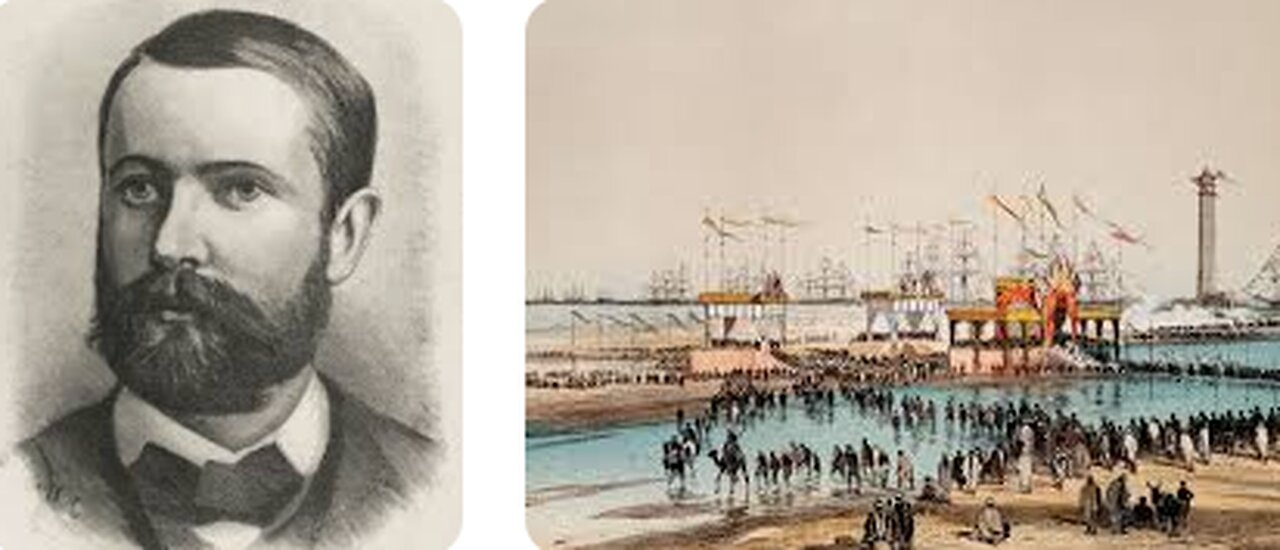Premium Only Content

Polish Genius : Inz Stanislaw Janicki - Suez Canal
The Pole who built the Suez Canal . The atmosphere that day was truly sublime. On November 17, 1869, after 10 years full of crises, political wars and the specter of bankruptcy, the most important artificial waterway in the history of world navigation was officially opened. The first unit to cross the Suez Canal was Napoleon III's 90-meter yacht called "L'Aigle" (The Eagle). The emperor's wife, Eugenia, sailed on board, followed by 47 steamships carrying the most important personalities in the world at that time. The parade started from Port Said and ended in Ismailia, 80 km away. The construction of this section, covering almost half of the canal's length, was supervised by a Polish engineer. Stanisław Janicki of the Rola coat of arms (born March 28, 1836 in Warsaw, died July 10, 1888 there[1]) - Polish construction engineer, hydrologist and inventor. He managed the construction of the Warsaw-St. Petersburg railway and the port in Fiume (now Rijeka). He collaborated on the construction of, among others, the Kierbedź Bridge in Warsaw and the Suez Canal[2]. He was the creator of his own modern concept of navigating rivers[3][4], in which he showed the relationship between the degree of their regulation and the type of soil, which was confirmed by practice. In 1871 he invented a floating dock for repairing ships.In Warsaw, he graduated from high school while practicing in a carpentry workshop, and later in the Machinery Factory of the Steam Navigation Society in Solec, owned by the Bank of Poland. In the years 1854–1856 he studied at the engineering faculty of the Technical University of Hannover in Germany[6]. From 1856, he was employed at the Goüin et Cie steam locomotive and iron bridge factory in Paris, where he worked with the French engineer Alexander Lavalley. This company supplied elements of the steel girder structure for the iron bridge over the Vistula, designed by Stanisław Kierbedź. In the years 1860–1864, she carried out works related to its construction in Warsaw. It was represented at the construction site by two representatives: the French engineer Cottard and Stanisław Janicki[7]. At that time, Janicki was the deputy construction manager. During his stay in Warsaw, he also participated in social life, including: on the recommendation of Józef Kraszewski, he cooperated with "Gazeta Polska" and was active in the Warsaw Charitable Society. In the years 1859–1869, he was a close collaborator of Ferdinand Lesseps in the construction of the Suez Canal, which connected the Mediterranean Sea basin, through the Red Sea, with the waters of the Indian Ocean. Janicki supervised the construction of the northern section of the Canal, from Port Said to Ismailia. Other Poles also took part in this construction, such as works manager Mieczysław Geniusz and clerk Cyprian Kuczewski. After the construction was completed, the wife of Napoleon III, Empress Eugenie, decorated the most distinguished builders for their contribution to the construction of the canal. Lesseps received the Cross of the Ages[8], and Janicki was awarded the Knight's Cross of the Order of the Legion of Honor. In 1870, together with engineers Cottard and Champouillon, he established a public works and railway construction company under the name Enterprise generale des chemins de fer et des travaux publics[5] and on its behalf he made numerous trips to many countries of the world. In 1871, during his stay in England, he tried to implement his idea of a floating dock into production. Due to lack of time and insufficient financing, the project could not be implemented, but in 1871 Janicki obtained an English patent for his invention - a floating dock for ship repairs[2], and in 1872 he managed to patent it in America. Janicki was also the author of the design of the sea canal in St. Petersburg and the waterworks in Odessa[5], which were implemented by other construction companies. The Austrian government entrusted him with the management of port works in Fiume (now Rijeka), after which, in 1879, he accepted the proposals of the Russian authorities to take over the management of the works on completing the canalization of the Moscow River. Janicki carried out construction works on a 170 km section from Moscow to Kolomna, where he installed movable weirs, fecal channels and locks in the river bed. To tow ships, the French system of pulling them using a steel rope placed on the bottom of the river was used for the first time in Russia[5]. After completing the work, Janicki served as the director of steam navigation on this river for several years. Later he also worked in the Donetsk Basin, contributing to the development of local mines. He was also one of the founders of the Society of Iron Ore Mines in Kryvyi Rih. Based on many years of study and engineering practice, in 1879 Janicki also developed his own theory of floating rivers. Two treatises on how to improve river navigation were published in four languages: Russian, French, German and Polish. They have been published, among others: in 1882 in the Polish technical magazine "Przegląd Techniczny"[10] and in book form in German. The publication attracted the attention of the hydrological community around the world and was also published in English under the title: Memoir on a New Kind of Movable Dam[11] in the United States, and its publication was financed by the American government. In 1883, Janicki returned to Warsaw, where he was involved in social, charitable and publishing activities - he initiated, among others, specialized Polish magazines "Zdrowie" and "Inżynieria i Budownictwo"[4]. He was also professionally active, including: He participated in the committee dealing with the city's sewage system. He tried to calm down disputes between engineers and develop a common concept of sewerage in Warsaw, taking into account various points of view. In it, he supported the designs of sewage channels by the British engineer Joseph Lindley, and at the same time persuaded him to make some modifications to the plans, taking into account the knowledge of Polish technicians who knew the local conditions and problems better[5]. He published a broad polemic on this issue in 1885 in "Gazeta Polska".
In 1887, a French consortium offered Janicki to take over the construction of the Panama Canal, but he rejected the offer[12]. Shortly before his death, Janicki received an offer from the Greek government to supervise the works of the Corinth Canal, but due to his health condition he did not agree to it.
-
 1:10:08
1:10:08
Donald Trump Jr.
6 hours agoWhat Real Leadership Looks Like, Live with Sen Bernie Moreno | TRIGGERED Ep.210
108K153 -
 1:38:57
1:38:57
Glenn Greenwald
4 hours agoWith Tulsi's Hearing this Week, Establishment Attacks her with Lies About Snowden & 702; U.S. Journalist Arrested in Switzerland for Criticizing Israel; China's Leap Forward in AI | SYSTEM UPDATE #397
42.9K54 -
 57:43
57:43
The StoneZONE with Roger Stone
1 hour agoWhat Will The JFK Assassination Files Reveal? | The StoneZONE w/ Roger Stone
11.5K6 -
 18:24
18:24
Tundra Tactical
4 hours ago $3.16 earnedWhats New With HRT Tactical Gear at SHOT Show 2025
13.7K2 -
 23:27
23:27
Rethinking the Dollar
4 hours agoWealth Protection SECRETS Learned from Wildfires w/ Paul Stone
6203 -
 LIVE
LIVE
Flyover Conservatives
20 hours agoInsider Reacts to Trump’s 100 Hours: Davos, WHO, Climate Change, DEI… - Alex Newman | FOC Show
420 watching -
 1:04:30
1:04:30
Battleground with Sean Parnell
7 hours agoPresident Trump Is Flooding The Zone
93.8K8 -
 UPCOMING
UPCOMING
We Like Shooting
13 hours agoWe Like Shooting 595 (Gun Podcast)
128 -
 LIVE
LIVE
megimu32
2 hours agoON THE SUBJECT: 90s Toys, Fat Phobia, and Crying Libs!
176 watching -
 LIVE
LIVE
Right Side Broadcasting Network
11 hours agoLIVE REPLAY: President Trump Addresses House GOP in Doral, FL - 1/27/25
4,919 watching